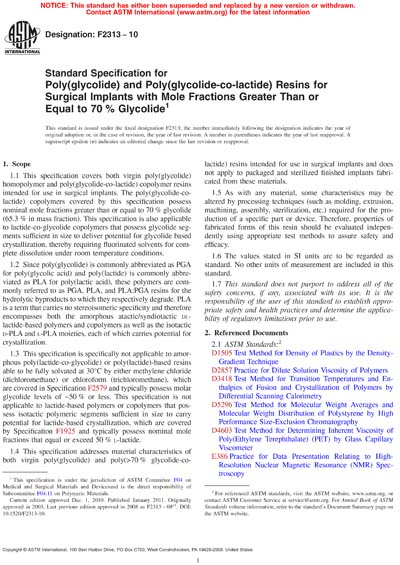Historical
ASTM F2313-10
Standard Specification for Poly(glycolide) and Poly(glycolide-co-lactide) Resins for Surgical Implants with Mole Fractions Greater Than or Equal to 70 % Glycolide
1.1 This specification covers both virgin poly(glycolide) homopolymer and poly(glycolide-co-lactide) copolymer resins intended for use in surgical implants. The poly(glycolide-co-lactide) copolymers covered by this specification possess nominal mole fractions greater than or equal to 70 % glycolide (65.3 % in mass fraction). This specification is also applicable to lactide-co-glycolide copolymers that possess glycolide segments sufficient in size to deliver potential for glycolide based crystallization, thereby requiring fluorinated solvents for complete dissolution under room temperature conditions.
1.2 Since poly(glycolide) is commonly abbreviated as PGA for poly(glycolic acid) and poly(lactide) is commonly abbreviated as PLA for poly(lactic acid), these polymers are commonly referred to as PGA, PLA, and PLA:PGA resins for the hydrolytic byproducts to which they respectively degrade. PLA is a term that carries no stereoisomeric specificity and therefore encompasses both the amorphous atactic/syndiotactic dl-lactide-based polymers and copolymers as well as the isotactic d-PLA and l-PLA moieties, each of which carries potential for crystallization.
1.3 This specification is specifically not applicable to amorphous poly(lactide-co-glycolide) or poly(lactide)-based resins able to be fully solvated at 30°C by either methylene chloride (dichloromethane) or chloroform (trichloromethane), which are covered in Specification F2579 and typically possess molar glycolide levels of ~50 % or less. This specification is not applicable to lactide-based polymers or copolymers that possess isotactic polymeric segments sufficient in size to carry potential for lactide-based crystallization, which are covered by Specification F1925 and typically possess nominal mole fractions that equal or exceed 50 % l-lactide.
1.4 This specification addresses material characteristics of both virgin poly(glycolide) and poly(>70 % glycolide-co-lactide) resins intended for use in surgical implants and does not apply to packaged and sterilized finished implants fabricated from these materials.
1.5 As with any material, some characteristics may be altered by processing techniques (such as molding, extrusion, machining, assembly, sterilization, etc.) required for the production of a specific part or device. Therefore, properties of fabricated forms of this resin should be evaluated independently using appropriate test methods to assure safety and efficacy.
1.6 The values stated in SI units are to be regarded as standard. No other units of measurement are included in this standard.
1.7 This standard does not purport to address all of the safety concerns, if any, associated with its use. It is the responsibility of the user of this standard to establish appropriate safety and health practices and determine the applicability of regulatory limitations prior to use.
Content Provider
ASTM International [astm]






